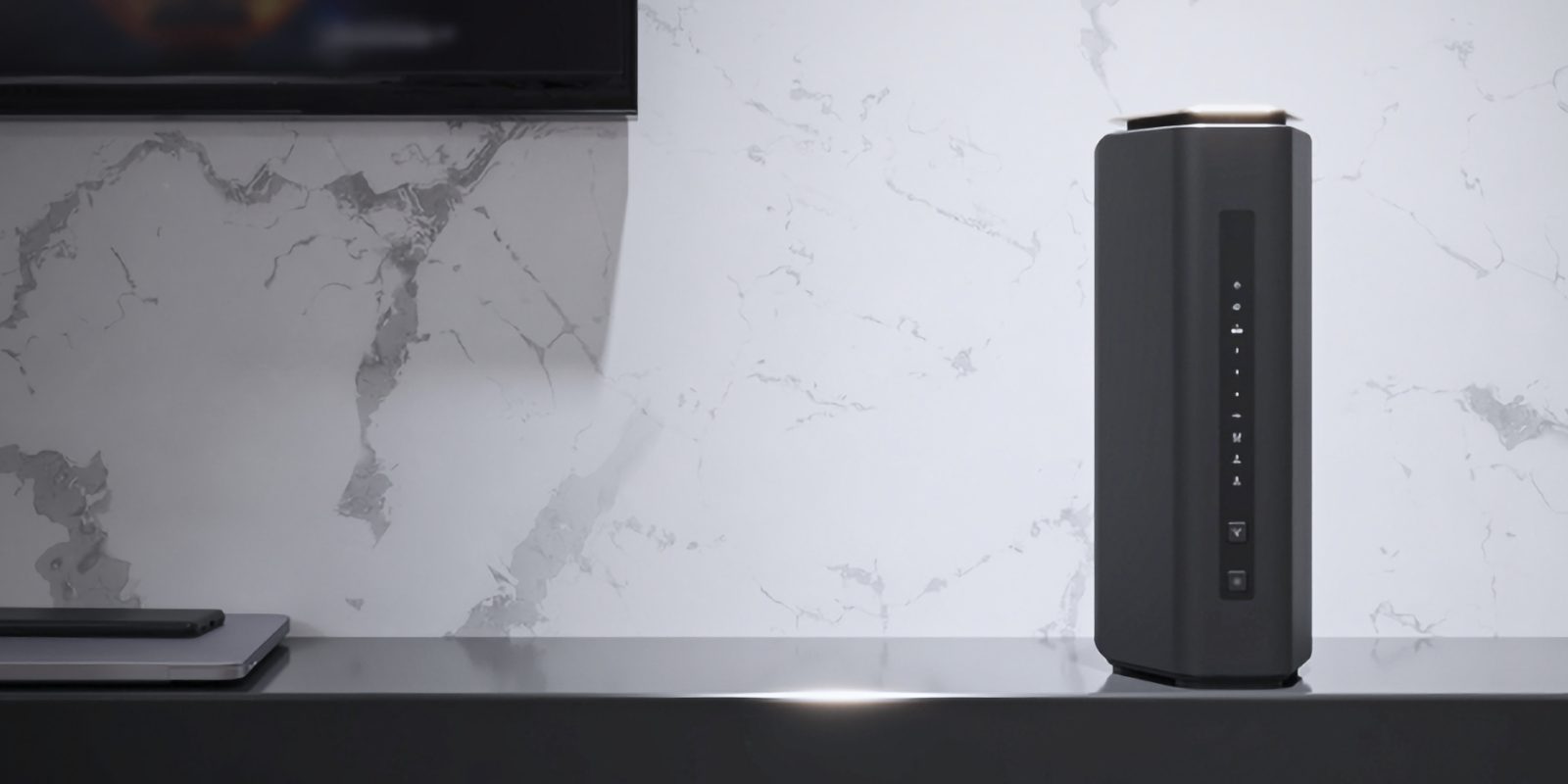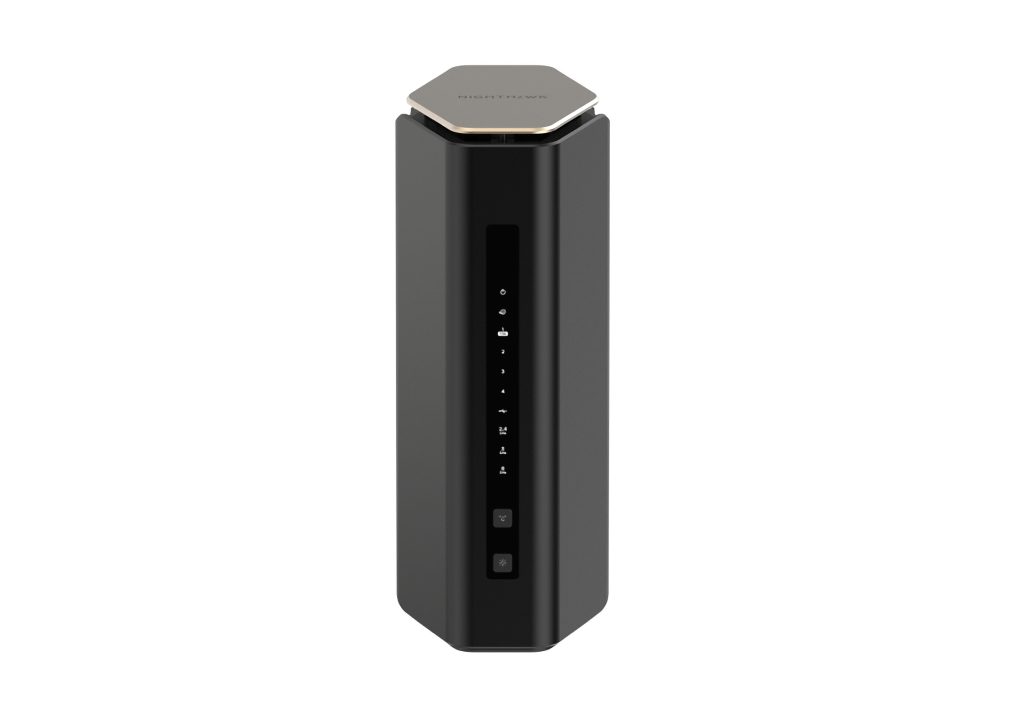
The Netgear Nighthawk RS600 is one of the first wave of WiFi 7 home routers on the market. While the RS600 is technically marketed as the mid-tier option in Netgear’s lineup, it is more than capable at delivering fast wireless internet across your home.
For Apple users, the relevance of WiFi 7 has come to the fore with the launch of the iPhone 16, which are the first Apple devices to tout WiFi 7 support. In this review, we’ll test out the Netgear RS600 speeds on WiFi 7 using the iPhone 16 Plus …
Design and build quality
The fit and finish of the router is very high, with solid build quality that is proportionate to its price point. The best performing routers will typically feature an external arrangement of spiky antennae to eke out the most speed and range possible. The RS600 opts to take aesthetics into account, housing everything inside a subtle hexagonal shape. This results in a practical-but-appealing black obelisk design, that will fit well into most people’s home spaces. I think these visual points matter as most people are forced to position their routers in a visible position in a room, like on a shelf or similar.
The RS600 housing is pretty compact too, measuring about 30 centimetres tall and 15 centimetres wide. It takes up the same amount of space as a large hardback book, which allowed me to hide it away from view entirely in a corner media cabinet. This is significantly smaller in dimensions than some other WiFi 7 capable routers, like the beast that is the Asus BE98, whose footprint is almost double the size thanks to its larger base, plus a tangle of outwardly-exposed antennas. In contrast, the RS600 fits well into my networking shelf, and is effectively silent in operation, so I wouldn’t know it’s there.
The router puts all of the I/O on the back. All of its ports are lined up neatly vertically on the back side, with the front featuring corresponding LED indicators for each port. The indicator will light up white if devices are using the full speed of that port, or orange if at a reduced speed. This means you can see at a glance if you have plugged all your Ethernet cables into the right spots. However, if you find lit white and orange LEDs distracting, I unfortunately could not find a setting to turn off the status lights.

Setup and app design
Setup using the Netgear Nighthawk app on the iPhone is very simple. It is close to plug-and-play. You follow a few steps using the wizard on the phone, and that’s about it. At one point, I did encounter a setup error, which as a review it was kind of nice to see how the app would handle a failure case. The app directed me to turn off the broadband modem, and restart. Indeed, on second try, everything went smoothly without a hitch.
I was migrating from an existing WiFi network, so as soon I set up the RS600, I renamed the default SSID and password to match those of my old router. This meant all my devices connected automatically, without having to enter network passwords again on everything. This is easily done using the app UI, or you can log into an advanced control panel in a web browser on your Mac to tweak more advanced configuration settings.
The app is serviceable, if basic. It has some conveniences like the ability to send notifications to alert you when new devices join the network for the first time. You can setup per-device profiles if you want to get a bit more fancy, like guest networks and the like, but I didn’t bother with any of that.
The app is slightly too pushy in forcing the Netgear Armor security subscription in your face, which I found of little value given the price charged. To be clear, the subscription is entirely optional, but you’ll be reminded you don’t have it every time you launch the app with a red text warning message. Admittedly, assuming everything is working, you shouldn’t need to launch the Nighthawk app very often after initial setup.
Wireless connections with WiFi 7
WiFi 7 is the latest generation of the WiFi standard, boasting even more theoretical bandwidth and faster speeds for wireless network devices. It includes features like multi-link operation (MLO), which negotiates the best wireless channel to use in the current environment to avoid interference. The WiFi 7 spec supports channels up to 320 MHz wide, which is twice the 160 MHz maximum of WiFi 6E.
But theoretical performance and real-world performance are very different things. Walls, floors and distance easily cut down on what speeds you can expect in practice. It also gets tricky with what manufacturers advertise, compared to what is possible under the domain of the spec.
Right now, Apple’s only WiFi 7 capable device is the iPhone 16 lineup. But while the RS600 can broadcast on channels up to 320 MHz, the iPhone 16 actually does not feature ‘full’ WiFi 7 support. Apple kept this somewhat quiet, but the iPhone 16 radios only communicate on up to 160 MHz spectrums, not the new 320 MHz channel enabled by the WiFi 7 spec. We’ll have to wait for future Apple devices to be able to take full advantage of what routers like the RS600 is capable of.
However, we can still report some impressive results. In my testing, the iPhone 16 Plus connected to the RS600 consistently achieved faster data transfer speeds than a MacBook Pro, and much faster than older iPhone models.
I tested multiple times at “short range”, “medium range” and “longer range” distances and took averages to get the following readings. Short range was within the same room as the router, only a couple of feet away. Medium range was about twenty feet, in the corner of an adjacent room through a wall. With the router situated downstairs, I did my long range test by going upstairs to the bedroom, with the connection needing to reach through the floor below. Testing was conducted using iPerf.
The iPhone 14 Pro on 5 GHz WiFi 6 achieved short range speeds of about 720 Mbps, similar speeds at medium range and a drop to about 550 Mbps on the long range test.
The M3 MacBook Pro with 6 GHz WiFi 6E was unsurprisingly faster, achieving about 980 Mbps at short range, 850 Mbps at short range, and 600 Mbps at long range. It is expected that 6 GHz penetration through objects is a bit worse than 5 GHz, which is probably why the long range test result is closer to the iPhone 14 Pro than at other distances, albeit still faster.
So, how does WiFi 7 on the iPhone 16 Plus fare? Despite the phone packing much smaller radios than a MacBook Pro, it outdid the MacBook Pro at every distance.
The short range speed broke the 1Gbps barrier, averaging at 1580 Mbps, 50% more than the MacBook Pro and double the iPhone 14 Pro’s wireless performance. In my testing, I saw a peak of 1728 Mbps.
Medium range was similarly impressive, tested at about 1390 Mbps average speeds. This is 60% faster than WiFi 6E on the laptop.
The improvements fall off significantly as distances increase. In the long range test, the iPhone 16 Plus achieved around 520 Mbps on average. This is actually slightly slower than the 14 Pro result, but natural variations in the environment have a lot of impact at these longer distances. Results on both of the phones at this distance fluctuated dramatically. I would imagine average performance over the long term would be roughly the same. The laptop won out at long range compared to the 16 Plus, probably because it has space for much beefier radios, that can maintain a stronger connection from further away. I would expect a comparable (future) WiFi 7 MacBook would easily beat it, of course.
At diametrically opposite places in my house, both phones circled around 150-200 Mbps speeds. The working range of the RS600 wireless was impressive, though. I used to use a mesh system, one for each floor of the house. Thanks to the long reach of the router, my wireless network needs are currently satisfied by a single RS600 router positioned downstairs.
It highlights though that the general trend with WiFi improvements of the last decade remains true; impressively faster speeds in close proximity, with the speeds falling off as you get further away.
Wired connections
The RS600 is lacking slightly in the number of super-high-speed Ethernet ports available. It has has two 10 Gbps capable Ethernet ports on the back, but one is also the dedicated Internet port. Whether you have >1 Gbps broadband or not, you have to use up that port. In the present day, having faster than 1 Gbps broadband speeds is pretty rare. Nevertheless, even if you can’t exploit all of the possible bandwidth today, you are very much future-proofed.
That leaves one more physical 10Gbps port on the router. If you have high-speed data storage, or a home server (perhaps a new Mac mini with the 10 Gbps option), they will have to occupy that singular 10 Gbps port. If you have more than one, you’ll need to share through a switch.
Otherwise, the router has three more Ethernet ports to connect peripherals, but they are capped at 1 Gigabit speed. Of course, most stuff doesn’t need more than a gigabit-per-second of bandwidth, but it somewhat defeats the point of a WiFi 7 router if everything you have connected via a wire cannot hit the WiFi 7 speeds. It would have been nicer if these ports were at least rated for 2.5 Gbps speeds, to give you more headroom for newer networked attached storage devices or similar. Competitors like the TP-Link BE9300 sports four 2.5 Gbps LAN ports, for instance.
Conclusion
The Netgear Nighthawk RS600 is great and has become my new home router, but it feels hard to recommend unreservedly right now. If you have a working WiFi network that you are happy with, it feels like jumping the gun to change out to WiFi 7 gear for the sake of it … most stuff just won’t be able to take advantage of the speeds yet.
Apple doesn’t even have full 320MHz WiFi 7 computers to buy yet. But obviously, the buying decision is situational. If your current wireless network is lacking in range or speed, and you have gigabit (or faster) internet to your home, and maybe you have a NAS or you just got a new Mac mini with a 10 Gbps Ethernet port, then getting a new WiFi 7 router like the RS600 suddenly becomes a no-brainer.
FTC: We use income earning auto affiliate links. More.




Comments